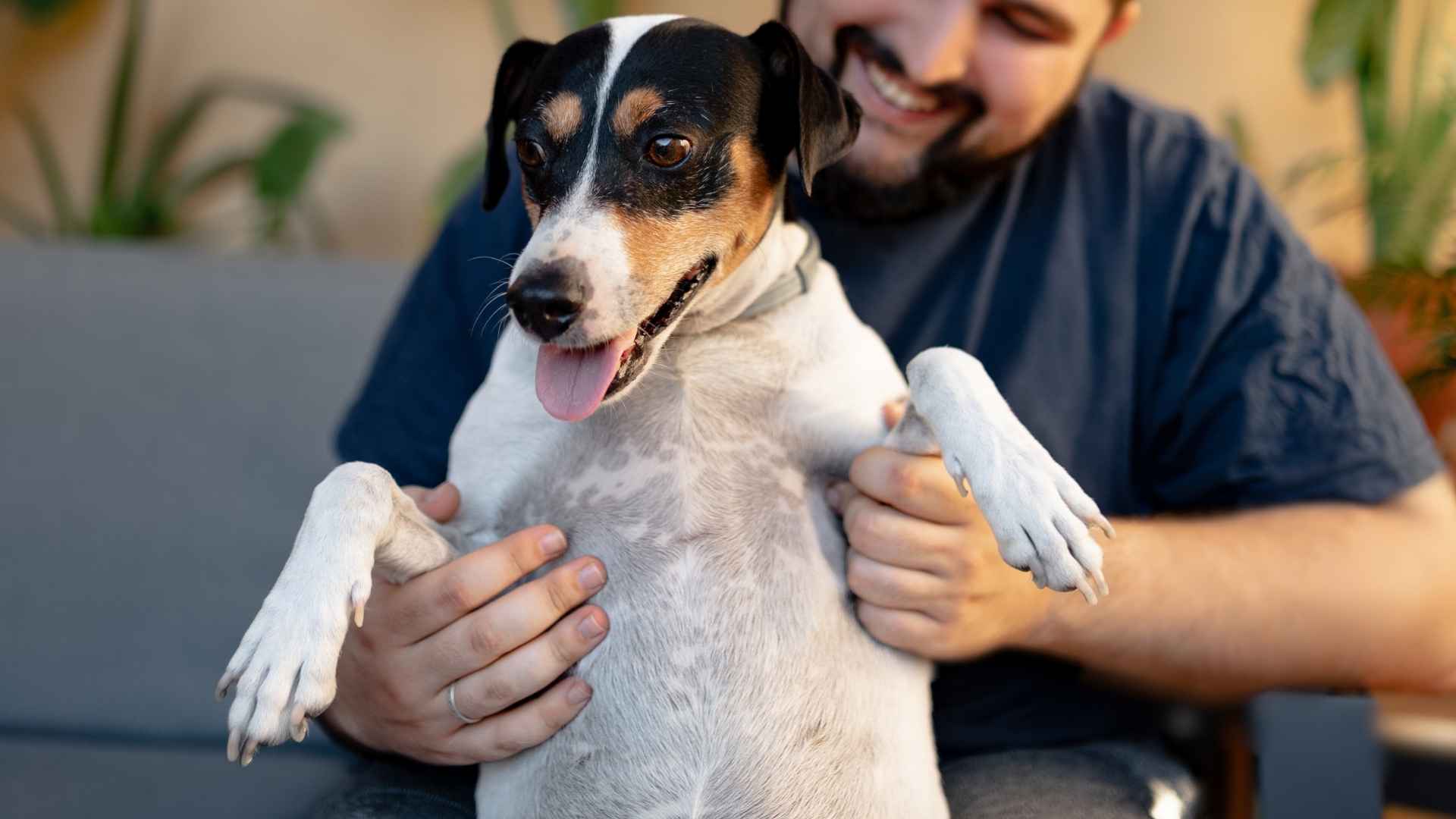Every dog has its quirks, but some breeds take eccentricity to a whole new level. From dramatic sighs that sound like teenage protests to oddly specific obsessions with socks, certain dogs are loved not just for their looks or loyalty, but for the peculiar behaviors that make them stand out.
These quirks aren’t flaws; they’re the little traits that turn everyday routines into laugh-out-loud moments for their owners. Whether it’s a breed famous for zooming in circles before dinner or one that insists on “talking back” in hilariously human-like ways, these canine oddballs prove that personality is just as important as pedigree.
In this article, we’ll explore dog breeds known for their funny, lovable habits, the ones that transform ordinary households into stages for daily comedy shows. If you’ve ever wondered which breeds bring the quirkiest joy to their humans, you’re in for a treat.
Dog Breeds With Funny Quirks Owners Love
1. Pug
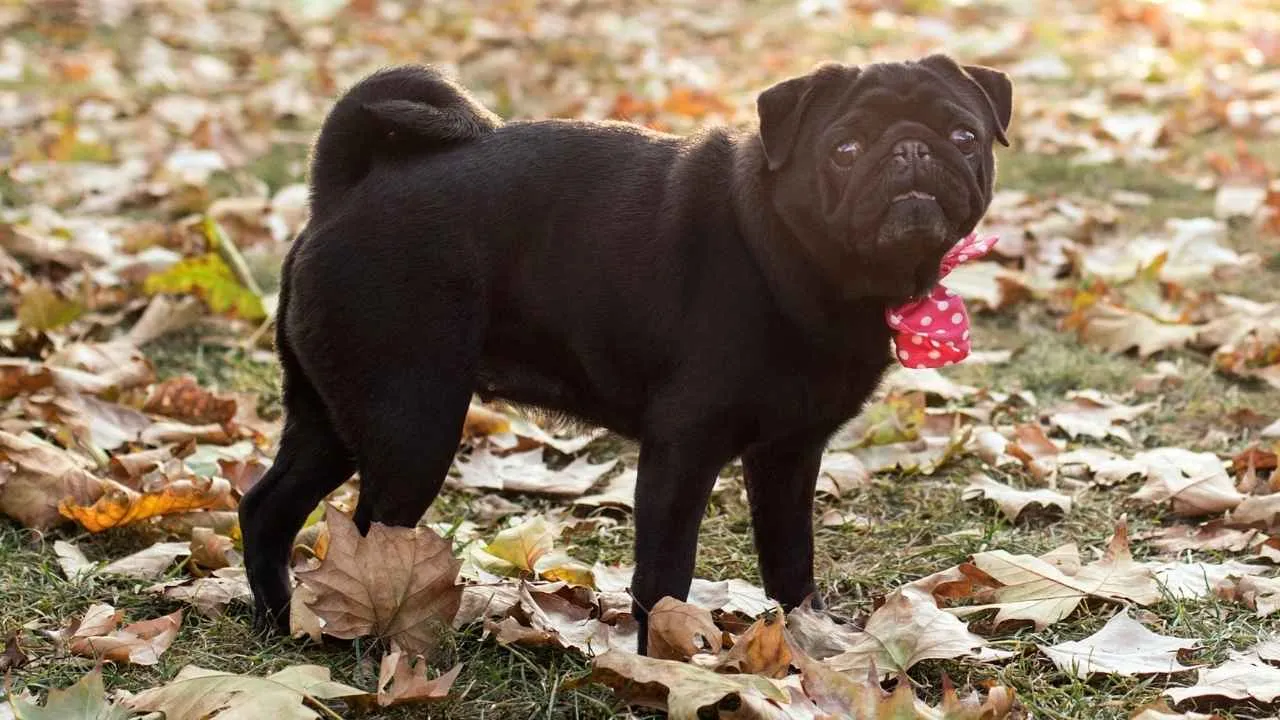
The Pug has a rich history that stretches back nearly 2,000 years, once cherished as a favored companion of Chinese emperors and later celebrated in European royal courts.
Recognized by the AKC in 1885, this toy breed carries the motto multum in parvo (“a lot in a little”), which perfectly captures its compact but spirited character. Its wrinkled brow, round eyes, and distinct expressions give it a personality that feels surprisingly human.
This small yet sturdy breed thrives in homes of all sizes, from apartments to country estates. While affectionate and people-oriented, Pugs are also known for their clownish antics, which make them a standout in any household. They enjoy being part of the action but are just as content snuggled up with their owners on the couch.
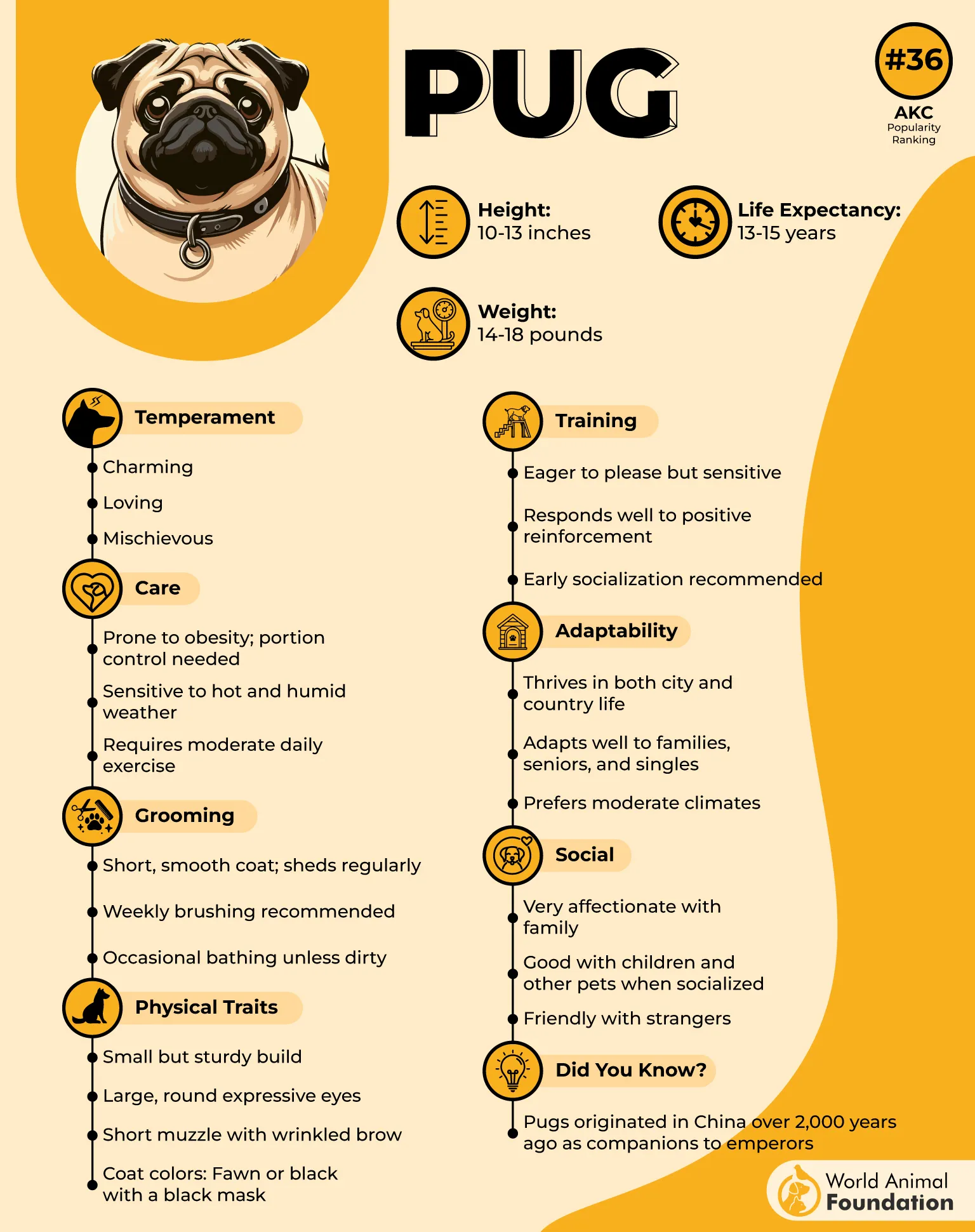
Health is an important consideration with this flat-faced breed. Their short muzzle can lead to breathing challenges, especially in hot or humid conditions, and owners must be mindful of exercise intensity and climate. Eye issues such as corneal ulcers are also known risks, making regular veterinary care and monitoring essential.
Pugs are eager to please and typically respond well to gentle training. They do best with positive reinforcement, as their sensitive nature does not tolerate harsh methods. Because they crave companionship, long periods of solitude can lead to unhappiness, so they flourish in homes where they are rarely left alone.
Maintenance is relatively straightforward, thanks to their short glossy coat. Weekly brushing helps keep shedding under control, while routine nail trimming and occasional baths are all that’s required. Combined with moderate daily activity and close attention to diet, these routines help Pugs stay healthy and happy.
Quick Tips
Avoid strenuous exercise in hot or humid weather to prevent breathing problems.
Keep meals portioned carefully to reduce the risk of obesity.
2. French Bulldog
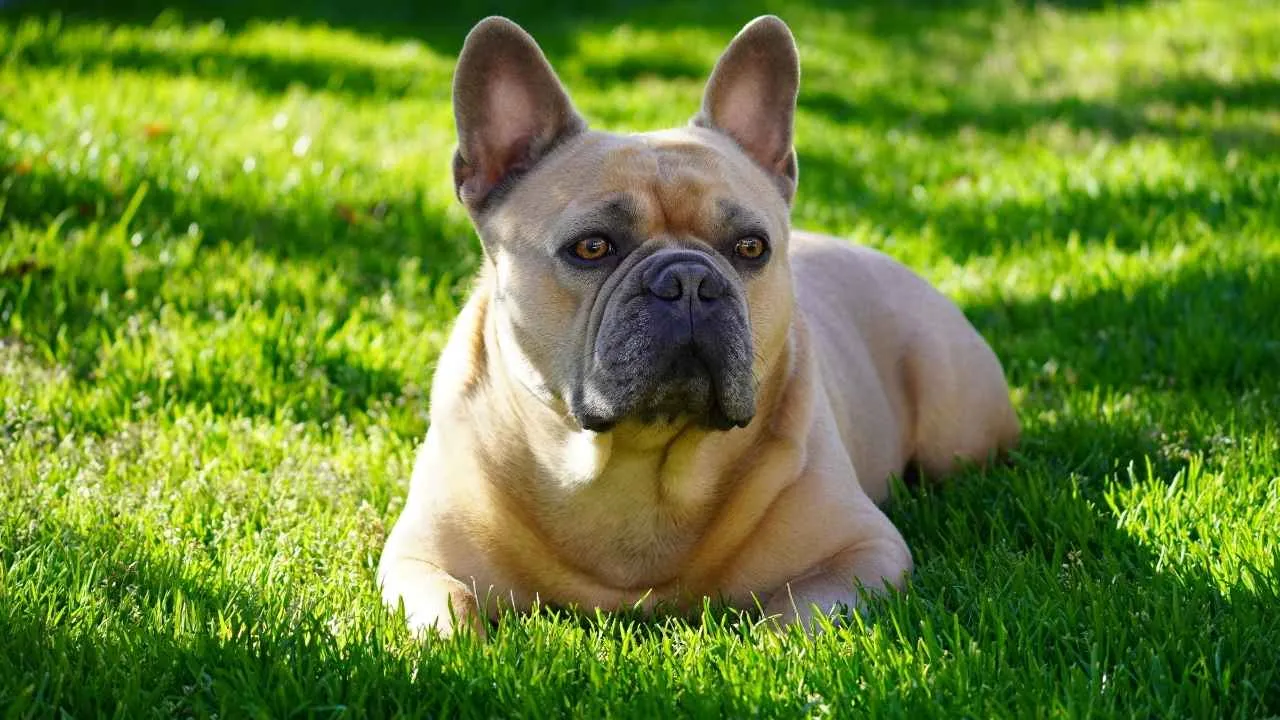
Developed in France during the late 1800s, the French Bulldog quickly became one of the most beloved small companion breeds. With its bat-like ears, compact build, and expressive face, the “Frenchie” is instantly recognizable. This breed exudes a more alert and lively appearance, paired with a cheerful disposition that charms dog lovers worldwide.
The French Bulldog’s physical traits demand mindful care. Its brachycephalic structure means that overheating and breathing difficulties are real concerns, especially in hot or humid climates.
Owners must monitor exercise carefully, ensuring their Frenchie avoids strenuous activity in warm conditions. Most cannot swim, so supervision around water is critical.

Despite their sometimes “grumpy” expression, Frenchies are known for a clownish, fun-loving personality. They thrive on companionship, are affectionate with children and seniors alike, and adapt well to city living. Their balanced mix of playfulness and relaxation makes them ideal pets for a wide range of households.
Health considerations include susceptibility to brachycephalic obstructive airway syndrome (BOAS), hip dysplasia, and skin issues around their facial wrinkles. Daily cleaning of the folds is important to prevent infection, and veterinary monitoring of airway health is advised. With proper care, their typical lifespan is 10–12 years.
When it comes to training, Frenchies can be both willing and stubborn. They respond best to patient, positive methods, and often excel when training feels like play. While not particularly vocal, they make moderate watchdogs, alerting their families to unusual sounds without excessive barking.
Quick Tips
Always keep exercise sessions short and avoid hot weather to protect breathing.
Clean and dry facial wrinkles daily to reduce the risk of infection.
3. Labrador Retriever

The Labrador Retriever has earned its place as one of the most popular breeds in the United States. Known for their affectionate nature, Labs are famously friendly with children, strangers, and other dogs, making them exceptional family companions. They originated as working dogs for fishermen, which explains their affinity for water and strong, athletic build.
Labs have a double coat that repels water but also results in heavy year-round shedding. Brushing two to three times a week helps reduce loose hair, though pet parents should expect a fair amount of dog hair at home. They need only occasional baths, but proper drying after swimming or bathing is important to avoid skin infections.
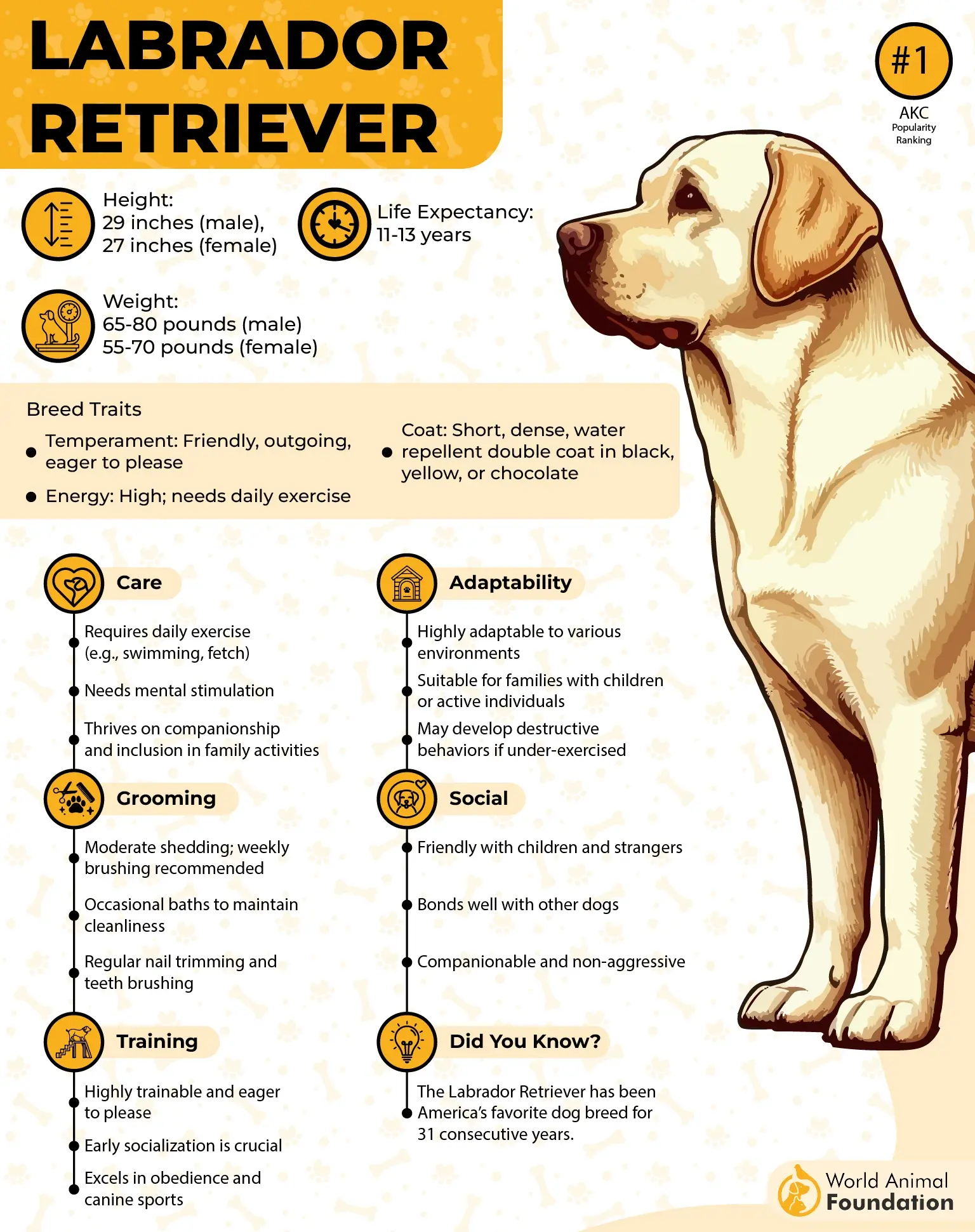
This energetic sporting breed thrives on daily activity. A Labrador needs at least an hour of exercise, such as swimming, hiking, or games of fetch, to stay both physically and mentally satisfied. Without adequate stimulation, they may turn to destructive behaviors, especially as curious puppies prone to chewing inappropriate items.
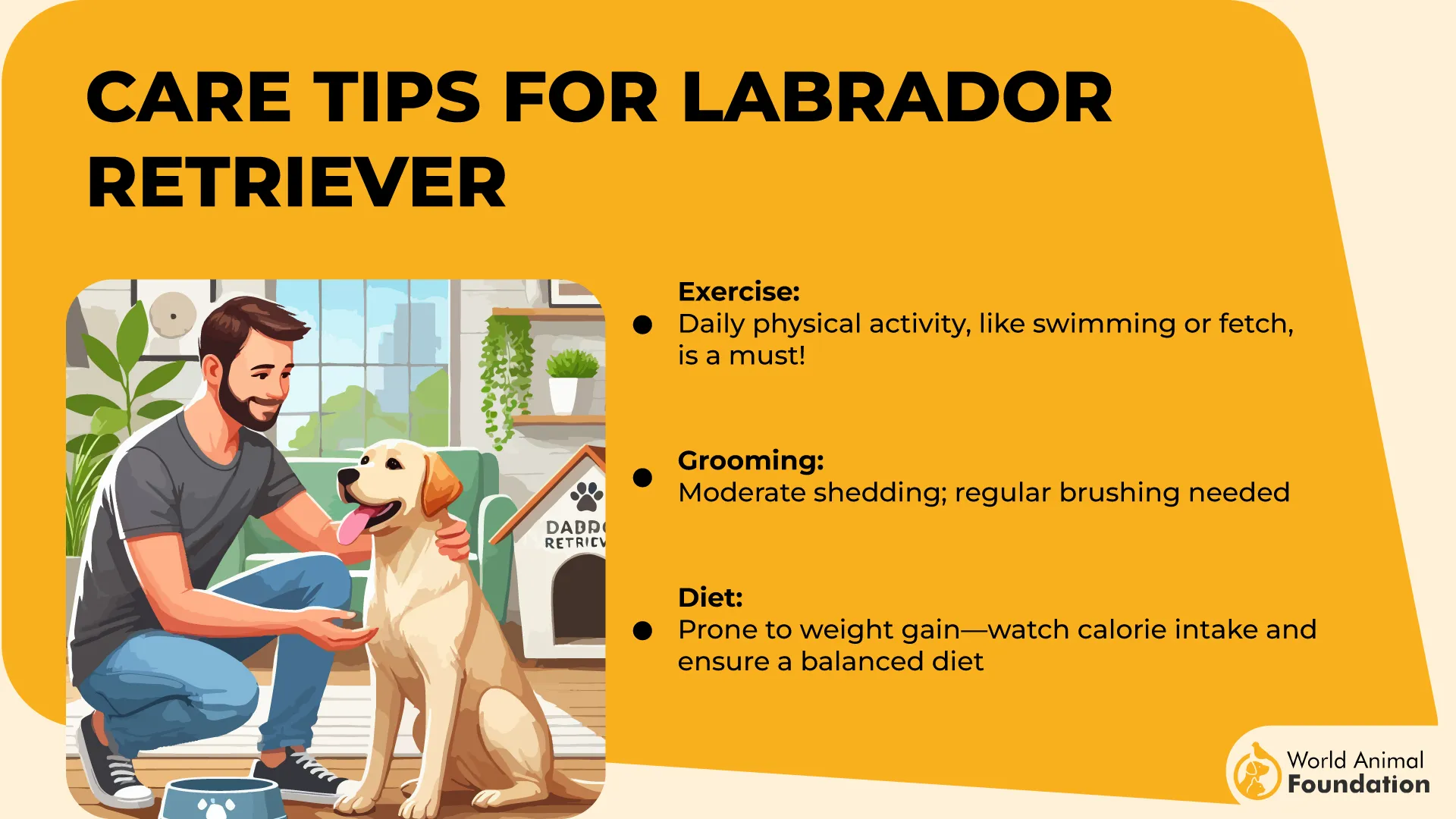
While generally healthy, Labradors can face several inherited conditions. Common concerns include hip and elbow dysplasia, ear infections due to floppy ears and water exposure, and progressive retinal atrophy.
They may also be at risk for exercise-induced collapse, tricuspid valve dysplasia, and certain cancers. Preventive vet visits and early detection are key to managing these issues.
Training a Labrador is typically rewarding thanks to their intelligence and eagerness to please. As per PetMD, they excel in obedience, agility, scent work, and even as service dogs.
Consistent socialization and correction of bad habits, like overexcitement or chewing, help ensure they mature into well-mannered adults. Their adaptable temperament makes them as suitable for therapy work as they are for active family life.
Quick Tips
Provide at least one hour of exercise daily to keep energy levels in check.
Clean ears every two to three weeks, especially after swimming, to prevent infections.
4. Boxer

The Boxer is a muscular, square-headed working dog originally developed in 19th-century Germany. Bred from mastiffs, bulldogs, and possibly Great Danes, they were first used for bull baiting and later for handling cattle in slaughterhouses.
Over time, they transitioned into versatile working dogs, serving as police dogs, guide dogs, and beloved companions. Their playful pawing motion, much like a human boxer, is one reason many believe the breed got its name.
With their broad chest, powerful build, and distinctive blunt muzzle, Boxers are striking in appearance. Their short coats can be fawn or brindle, often with white markings, and their black face mask gives them a noble expression.
While grooming needs are minimal, they do shed moderately, and occasional brushing keeps their coat glossy. Regular rub-downs or use of a grooming mitt also help maintain their sleek look.
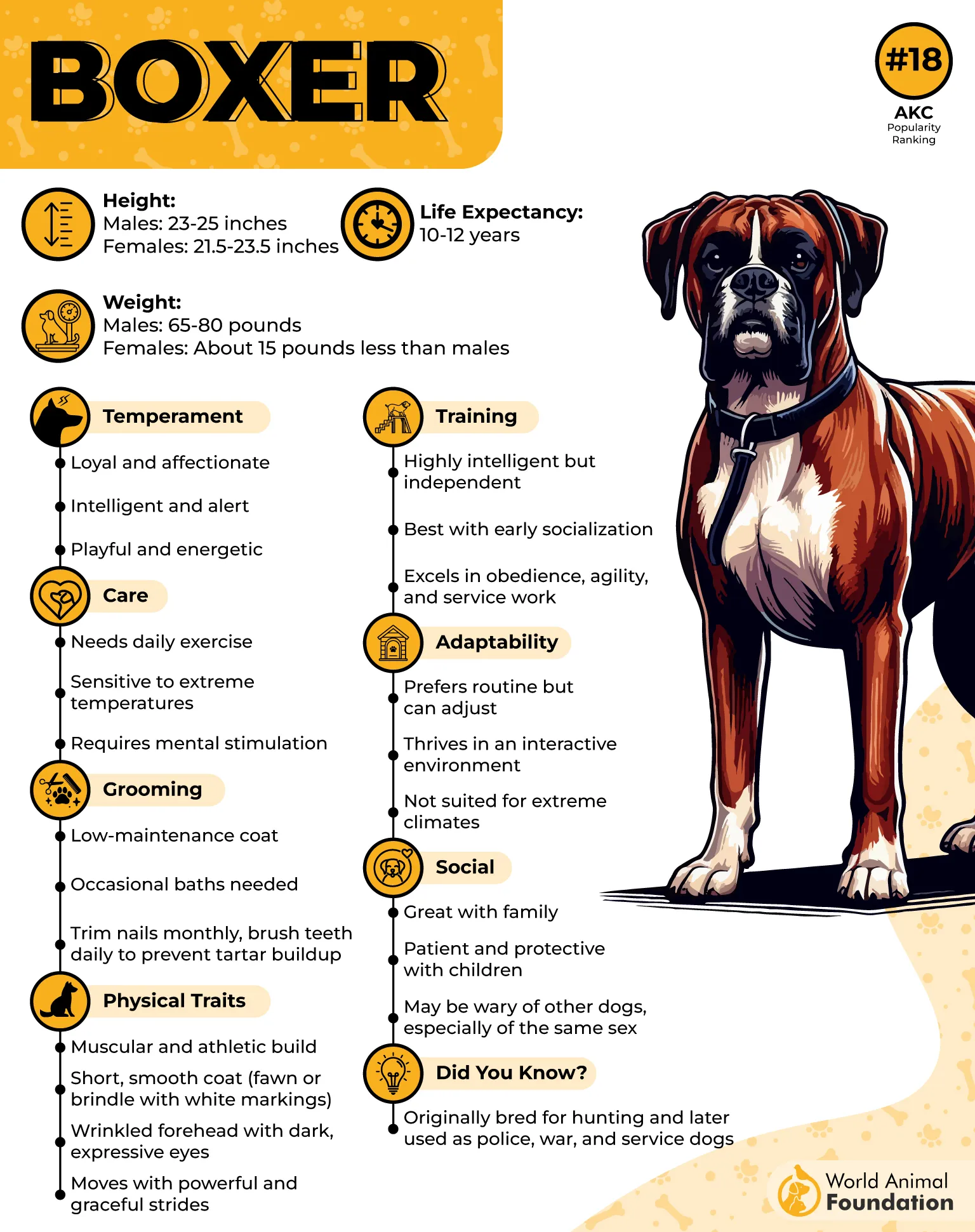
Boxers are affectionate, people-oriented dogs that thrive on companionship. They dislike being left alone for long periods and may become destructive if bored. Their loyalty makes them excellent watchdogs, though they typically bark only when there’s a good reason.
They are also playful and vocal, often making distinctive growling sounds that serve as their version of “talking.”
High-energy by nature, Boxers need consistent exercise. A daily routine of at least 40 minutes of active play, running, or long walks helps prevent restlessness. They adapt to city apartments or country homes as long as they can expend their energy. Owners must take care in both hot and cold climates, as Boxers are sensitive to temperature extremes.
The breed’s average lifespan is eight to ten years, shorter than some other medium-to-large dogs. Some Boxers drool, snore, or snort more than others, quirks that many owners find endearing.
With the right mix of companionship, training, and care, Boxers are devoted family pets known for their affection toward children and protective instincts toward the household.
Quick Tips
Provide at least 40 minutes of exercise daily to channel energy positively.
Avoid excessive heat or cold, as Boxers are sensitive to temperature extremes.
5. Golden Retriever

The Golden Retriever was first developed in Scotland in the 19th century to serve hunters as a gundog and water retriever. With a thick, water-resistant coat and strong swimming ability, it quickly became a favorite among sportsmen.
Golden Retrievers have a dense double coat that requires consistent upkeep. Twice-weekly brushing is the minimum, though daily care is best during heavy shedding seasons. Occasional baths keep the coat clean, while a healthy diet helps preserve its shine.
Because they are prone to obesity, monitoring food intake and feeding large-breed puppy formulas during growth stages helps protect against hip dysplasia.

This sporting breed needs at least an hour of exercise daily. Games of fetch, hiking, and swimming are natural outlets for their energy and retrieving instincts.
They also excel in structured activities like agility, dock diving, and obedience competitions, where their intelligence and eagerness to learn shine. Off-leash exercise is safest in fenced areas, since their enthusiasm can lead them to roam.
The Golden Retriever’s temperament is one of its most defining traits. Known for their friendliness, they are affectionate with family, playful with children, and generally accepting of other dogs and strangers. While they can serve as decent watchdogs, their easygoing nature means they lack the protective edge of some other breeds.
Britannica states that training is typically successful due to their intelligence and desire to please. However, young Golden Retrievers can be easily distracted, making early sessions a test of patience.
With consistency and positive reinforcement, they mature into obedient, adaptable adults that are well-suited to a wide range of households. Their reputation as therapy and guide dogs underscores their reliability and balanced temperament.
Quick Tips
Provide daily retrieving games or swimming sessions to meet exercise needs.
Brush the coat at least twice weekly to manage shedding and prevent tangles.
6. Siberian Husky

The Siberian Husky was developed by the Chukchi people of northeast Asia over 3,000 years ago to serve as sled-pulling companions. Compact, athletic, and resilient, they were bred for endurance in harsh climates.
Their fame spread globally after a team of Huskies delivered life-saving serum during the Nome diphtheria outbreak, a feat later immortalized in the film Balto.
With erect ears, striking eyes (sometimes one blue and one brown), and a dense double coat, the Husky is built for cold weather. The coat ranges from pure white to black and often features distinctive facial markings.
Grooming needs are moderate, with brushing a few times weekly, increasing significantly during shedding seasons. Despite the heavy undercoat, their shorter outer coat resists matting.
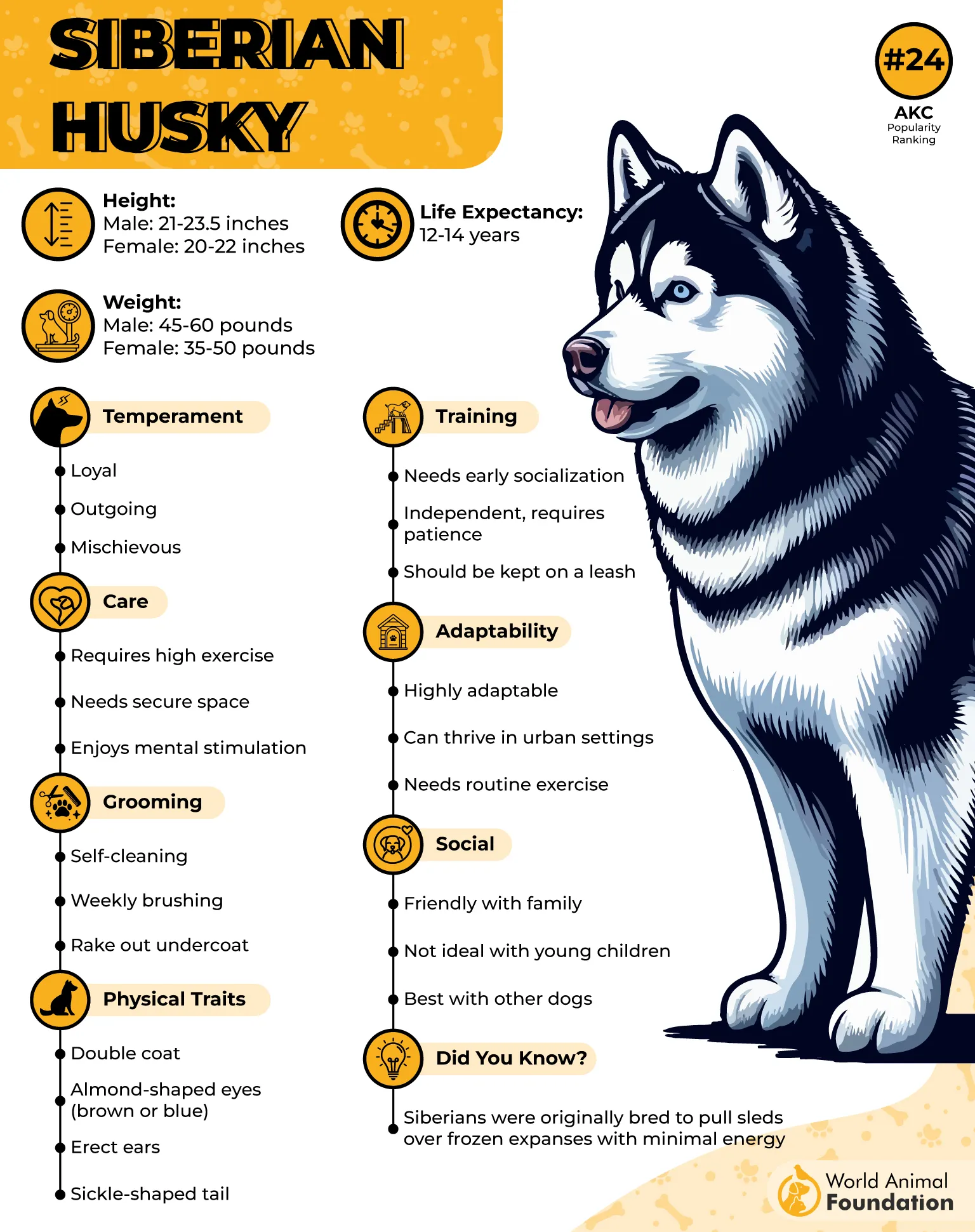
Siberian Huskies are intelligent but notoriously independent, often testing boundaries. They thrive on gentle but firm training and early socialization.
Their love of running can outweigh loyalty in certain situations, so off-leash exercise is safest in enclosed spaces. Many Huskies also enjoy activities like sledding and ski-joring, which let them use their heritage skills.
This breed’s temperament is outgoing and friendly. While not natural watchdogs, Huskies may bark and are generally good with children and other dogs when raised together. However, their strong prey drive makes them unreliable around cats or small animals. They are also more prone to howling than barking, a vocal trait owners often find entertaining.
Daily exercise is essential, with runs or vigorous play a few times a week to keep them healthy and mentally stimulated. Left alone too often, Huskies may dig, chew, or serenade the neighborhood with their howls. Hardy and adaptable, they live on average 11–13 years, provided their need for activity and companionship is met.
Quick Tips
Provide secure fencing, as Huskies are escape artists and love to roam.
Increase brushing during shedding season to manage heavy undercoat loss.
7. Bull Terrier
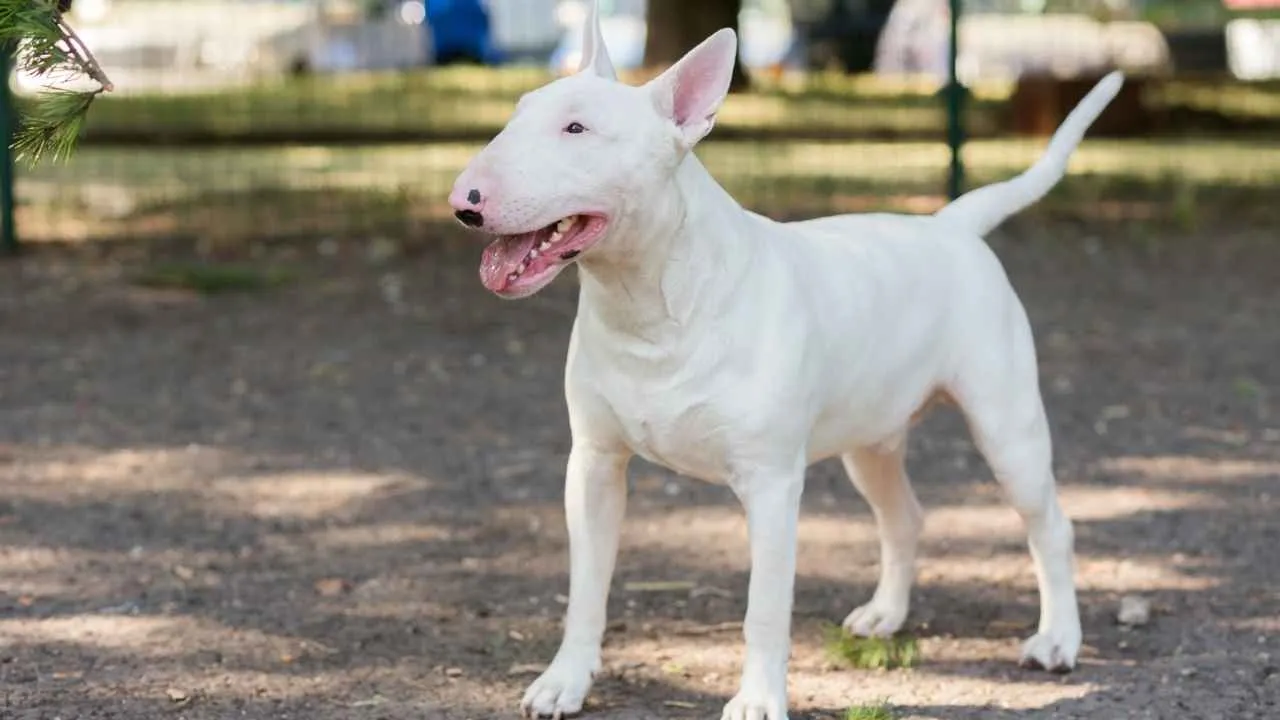
The Bull Terrier is instantly recognizable with its egg-shaped head, triangular eyes, and muscular build. First recognized by the AKC in 1885, it has moved far from its bull-baiting origins to become a beloved family dog. Its quirky look and presence in media—like the famous Target dog—make it one of the most distinctive.
Playful and clownish, Bull Terriers are often described as energetic “kids in dog suits.” They crave companionship and thrive on being part of the family, happily climbing into laps when they’re in the mood or clowning around when playtime starts.
Early socialization helps channel their enthusiasm, especially since they may not always get along with unfamiliar dogs or cats.
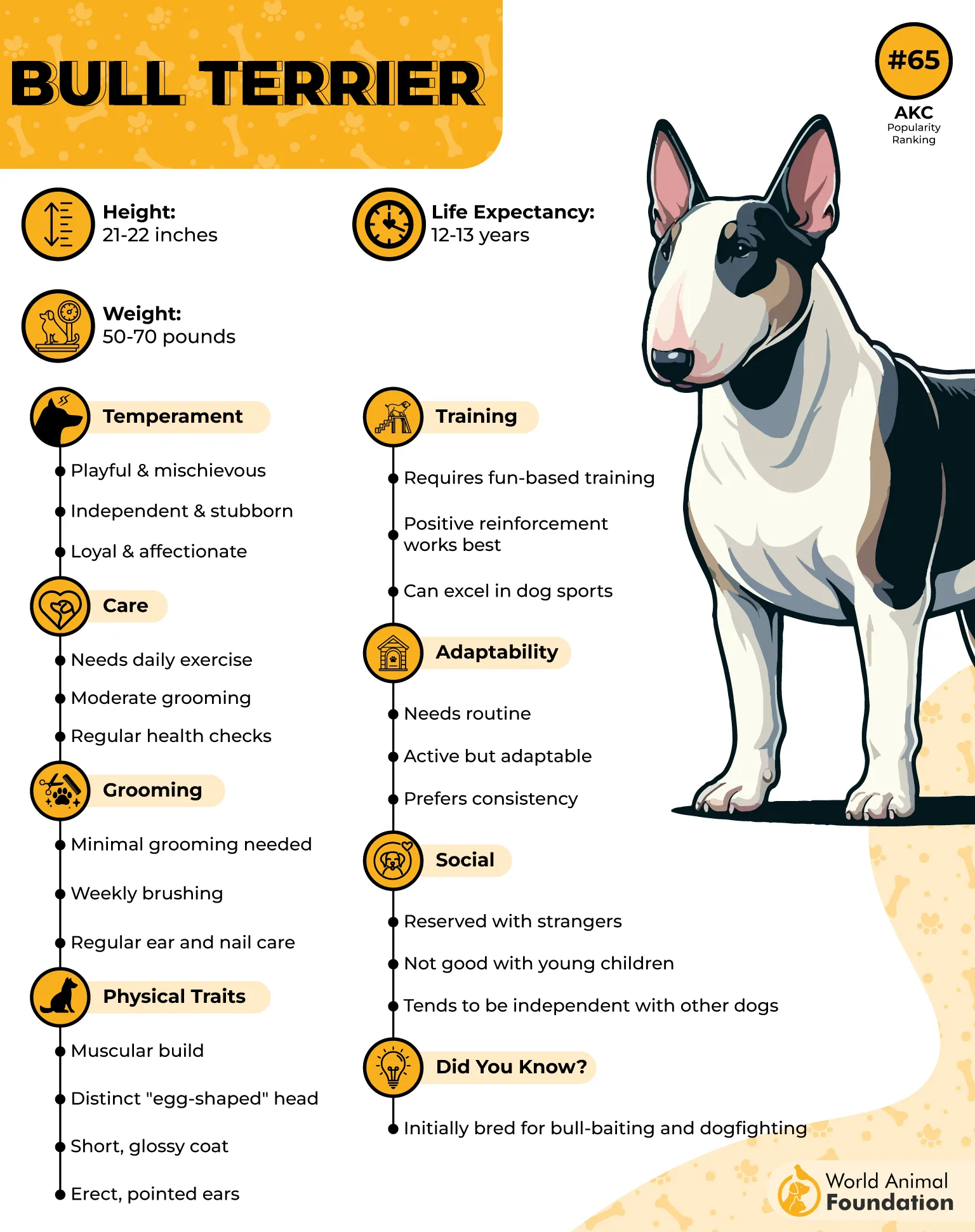
These dogs require consistent exercise and mental stimulation to prevent destructive behavior. A daily walk combined with activities such as agility, nose work, or obedience games helps keep them satisfied. Left alone for long hours, Bull Terriers may chew furniture, chase their tails, or find creative ways to burn off energy.
Health concerns for the breed include patellar luxation, mitral valve dysplasia, hereditary nephritis, and a predisposition to deafness, especially in white-coated Bull Terriers. Owners must remain vigilant with veterinary checkups and consider preventive screening where possible.
Training a Bull Terrier takes patience and consistency. They are intelligent but independent, often requiring motivation in the form of treats, toys, or praise.
When properly guided, their athleticism and eagerness to engage make them excellent companions for activities like agility or Fast CAT, blending fun with discipline.
Quick Tips
Use early training and consistent positive reinforcement to manage independence.
Supervise closely around children and other pets until socialization is firmly established.
Conclusion
Living with a quirky dog is like having a built-in comedian in the house. Breeds such as the Pug, French Bulldog, Labrador Retriever, Boxer, Golden Retriever, Siberian Husky, and Bull Terrier each bring their own unique humor to daily life, filling homes around the world with laughter and joy. Yet they’re not the only ones known for their delightful antics. Other breeds, such as the Cavalier King Charles Spaniel, charm with their constant need for affection and adorable short snouts that make every sight of them a point of pure excitement.
Beagles, too, have a well-earned reputation for hilarity. From pups that make a mess in bed to adults that eat anything within mouth’s reach, their uncommon sense of humor and jumping legs keep owners on their toes. She’s owned one? Then she knows the trouble and absolute hilarity they bring to a litter of memories. At the end of the day, whether a dog is dozing in sleep or bouncing with excitement, every quirk is a reminder of the joy of being a devoted “dog person.”


